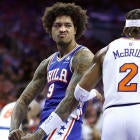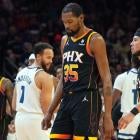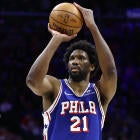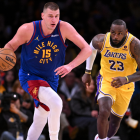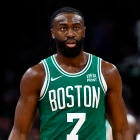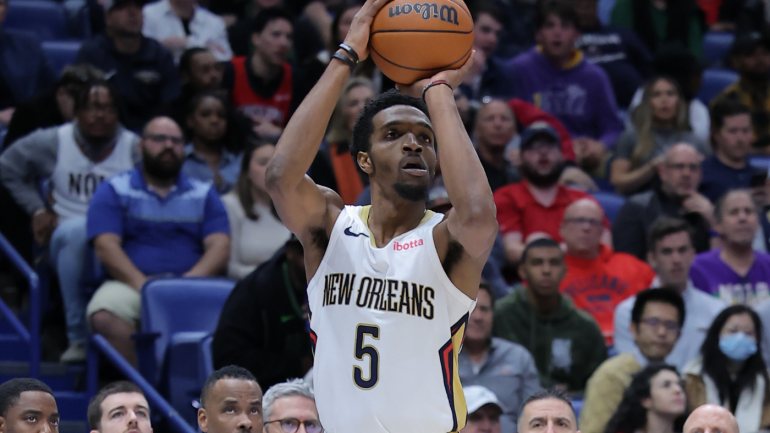
It took no time for Herb Jones to establish himself as one of the NBA's best defenders. Before he even played a preseason game, his New Orleans Pelicans teammate Trey Murphy III nicknamed him Straitjacket and "Not on Herb" became something of a rallying cry for the team. He was a starter almost immediately, badgering star scorers and blocking jump shots.
Offense was another story. Jones entered the league a good cutter and ball mover, and he was dangerous in transition, but he was available with the No. 35 pick in the 2021 draft because his shot required reconstruction. When he got on the floor with Fred Vinson, the Pelicans' resident shot doctor, at summer league in Las Vegas, Jones understood that he'd have to be patient. That didn't mean it was easy to handle opponents completely ignoring him outside the 3-point line, daring him to shoot.
"If you got the label as a non-shooter, it feels like every shot is the game-winner," Jones said.
Vinson wanted Jones, a southpaw, to keep his feet square to the basket, generate power from his base and release the ball on the left side of his body. "It's been a lot of work, bro," Jones said. "In the summers, me and Coach Fred, we probably go to the gym at 9, work out, I probably lift, then we shoot again after." After his rookie season, he spent so much time at the practice facility in New Orleans that teammate Larry Nance Jr. offered to pay for him to go on vacation, an offer Jones did not accept.
Twenty-nine games into this season, Jones' third, his effort was still not translating to better shooting numbers during games. His 3-point attempts had risen on a per-possession basis, but he was making just 30.9% of them -- even worse than what he'd managed in his first two years. Then, seemingly overnight, shots started falling -- 3 for 5 against the Lakers, 2 for 4 against the Nets, 4 for 5 against the Timberwolves -- and they haven't stopped. From Dec. 31 onward, a 28-game sample size, Jones has shot 54.5% from 3-point range, the best mark of anyone in the NBA (minimum 45 attempts).
When a kickout pass finds him open, Jones is not hesitating. He's shooting with the conviction that his jumper is a weapon, not a last resort.
"He's made a lot of strides," Murphy said, "especially from his rookie year, where there was times when he wouldn't want to shoot the ball at all. And now he's shooting over contests."
Jones is now shooting 43.6% from deep on the season, 10th among players who qualify for the official leaderboard. He has been equally accurate in the corners and above the break, and he's been getting 3s up about as frequently as Kentavious Caldwell-Pope and Bradley Beal. Jones is not going to get any Most Improved Player buzz -- his scoring is only slightly up, and his usage rate hasn't budged -- but this specific improvement is as meaningful as any in the league.
For all of his defensive stops and energy plays, the pre-2024 version of Jones came with questions: Could he stay on the floor in the playoffs against top-tier defensive teams? What lineups would accommodate him? The 2024 version is the kind of player coaches can't take off the floor, the kind who can play with anybody, amplifies stars and makes everything simpler. Guys like that who defend at an all-world level -- think OG Anunoby or Phoenix-era Mikal Bridges -- are more in demand than any other type of player, save for superstars. Jones is in the first year of a four-year, $54 million contract extension; if his shooting is merely reliable going forward, that contract is a steal as spectacular as any play Jones has ever made.
Defenders aren't treating Jones like he's Stephen Curry, but he has noticed a difference. Before, opponents would usually "either put a big on me or the weakest defender," Jones said. "Now, I wouldn't say it's the best defender because we have so many offensive weapons, but it's not the worst defender now." All along, Jones has been developing his off-the-dribble game, but it was difficult for him to show it off before he started seeing close-outs.
"I've kind of been waiting on that," Jones said. "'Cause I continue to work on my finishing packages, reads off of close-outs. So to see guys closing out now is a huge plus. And I just try to get out and make the right play every time."
"When the ball touches his hands on the perimeter, he's making great decisions," New Orleans coach Willie Green said, "whether it's taking a shot, shot-fake and drive, swinging it to a teammate, rim decisions."
Jones played point guard in eighth grade and as a freshman in high school on the varsity team. He was a point forward at Alabama, and he's been a connector throughout his time in New Orleans. "I always tried to learn every position on the floor," he said. "Growing up, I wasn't the tallest, I wasn't the most skilled, but the teams that I played on, we always played together, played the right way, played hard," Jones said. He wanted to "be the best teammate," which meant knowing where he -- and everybody else -- was supposed to be.
Jones' approach is the same with the Pelicans, who, due to injuries (CJ McCollum, Dyson Daniels) and a suspension (Jose Alvarado), turned to Jones to initiate offense in recent games against the Chicago Bulls and New York Knicks. On one possession against Chicago, he brought the ball up, passed it to the high post, cut to the rim off a back screen and, in one smooth motion, fired a behind-the-back touch pass to the corner for an assist.
Murphy said "it doesn't surprise me at all" that Jones can make plays like this. Jones, however, said that, even in his point guard days, he "didn't ever throw behind-the-back passes." This was simply what the moment called for.
"It was just kind of an instinct thing," Jones said. "Like that was kind of the only way I was going to be able to get the ball out there quickly. And my boy knocked down the shot."
The Pelicans are 37-25 and have won 11 of their last 15 games. They are fifth in the Western Conference despite injuries robbing them of lineup continuity, and they've put themselves in position to beat out several teams that get much more attention -- the Warriors, Lakers and Mavericks -- for a top-six (i.e. non-play-in) spot. Jones has been an enormous piece of this puzzle, and Green described him as "one of our most stable players." After watching him get extra shots up for years, Green believes he earned the confidence he's playing with.
"He's been the hardest-working guy in practice," New Orleans center Jonas Valanciunas said. "He's been staying true to what he does. He's evolving, he's growing. I'm just happy to see him succeeding that much."
Herb knew that was money.
— New Orleans Pelicans (@PelicansNBA) February 26, 2024
too cold. 🥶 pic.twitter.com/GzTH0lgeXH
Part of Jones' evolution was getting comfortable with misses (or, as Murphy put it, "just not caring" about being left unguarded). The message from his teammates and coaches stayed consistent, Jones said: "They just tell me go out and don't even think, just go out and hoop." He did his best to do just that.
"We changed my mechanics when I first got here, but, you know, the adjustment took so long," Jones said. "And I was trying to get comfortable in what I was doing. But I knew there was going to be some growing pains because I had to go out and be uncomfortable when they were leaving me open. It's almost like you have no choice but to shoot the ball."
These days, he is simply "trusting my work and trying to knock down the open ones," Jones said. He's feeling good about his offensive game, and he's "going out and playing free."
"Now I don't even have to encourage him to shoot the ball," Murphy said.
On the rare summer days when Jones is at home in Greensboro, Alabama, rather than in New Orleans, he's still usually on the court. The difference is that, without Vinson, he doesn't need to stick to a set shooting-and-lifting schedule. "I kind of just stay in the gym," he said, until he feels like he has done enough. When it comes to skill development, he knows it is best to focus on where you're trying to go, not how much time it is taking to get there.
"Whatever I need to get done, I get done," Jones said. "However long it takes."














